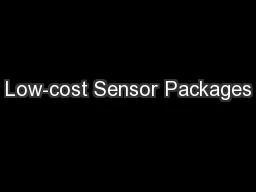

for Roadside Emissions Factor Estimation CMAS 1072015 Karoline K Johnson Michael H Bergin Duke University Armistead G Russell Georgia Institute of Technology 1 Overview Advantages of lowcost sensing ID: 729610
Download Presentation The PPT/PDF document "Low-cost Sensor Packages" is the property of its rightful owner. Permission is granted to download and print the materials on this web site for personal, non-commercial use only, and to display it on your personal computer provided you do not modify the materials and that you retain all copyright notices contained in the materials. By downloading content from our website, you accept the terms of this agreement.
Slide1
Low-cost Sensor Packages for Roadside Emissions Factor Estimation
CMAS – 10/7/2015Karoline K. Johnson, Michael H. Bergin, Duke UniversityArmistead G. Russell, Georgia Institute of Technology
1Slide2
Overview
Advantages of low-cost sensingApplications of interest to modelingEmissions factors estimation
2Slide3
Inexpensive ($10 - $6000)
Many models commercially availableSmallLightweight
Low power consumptionEasier to use and maintain once assembled
Real-time fast responsePortable and robust
Advantages of
S
ensors
US
Federal Equivalence
Method
$40,000
Shinyei
particle sensor
$100
3
Img
sources: Shinyei.co.jp,
www.navajonationepa.org
/aqcp/AirMonitoringSite.htmlSlide4
Applications4Slide5
Spatial and Temporal Distribution
Low-cost and low upkeep allows more nodesReal-time data
PortableIdentifying hot spots
Find areas higher than expectedDeploy more expensive equipment in specific locations of interest
PM
2.5
comparison across campus (~1 mile)
Sensor Pilot – Georgia Tech
5Slide6
Health Studies
Estimating exposureCan use network of sensors to estimate ambient concentrations throughout a community in microenvironments
Indoor and outdoorSome sensors can be used as personal monitors
6Slide7
Other applications
Mobile monitoringCitizen science
Not feasible at this time
LitigationRegulatory compliance
7Slide8
Emissions Factors
Locate sensors near roadways and other sources Calculate based on pollutant and CO2 concentrations
Emissions factors variable regionally and over time
8Slide9
Sensors & Modeling
Benefits of sensors for modelingAdditional data for inputs, training, and evaluation of models (especially important for fine-scale modeling)Custom emissions factors for models
Benefits of modeling for sensorsCombining sensor data into useful product (concentration over a city, etc.)
Identifying problematic nodes in network
9Slide10
Emissions Factors Estimation
10Slide11
Railyard
Emissions Factors: Conventional Instruments
(
Galvis
et al., 2013)
11Slide12
12
Railyard
Emissions Factors
: Conventional Instruments cont.
(
Galvis
et al., 2013)Slide13
COZIR
CO
2
s
ensor
temperature and humidity sensor
Shinyei
PM sensor
Arduino-microcontroler
microAeth
– black carbon
Sensor Package
Monitoring station and sensor package installation
(Atlanta, GA)
13
Road Emissions Factors: Low-cost SensorsSlide14
Package Design for Emissions Monitoring
Shoebox-sized
Weatherproof design
Fan draws air through the box
Price:
1-2 orders of magnitude less expensive
PM
2.5
, CO
2
, and microcontroller
~$400
+ Optional
microAeth
~$6,000
+ Optional gas-phase
sensors ~$200 each
(CO, NO, NO2, O
3-Alphasense)14Emissions Package Deployed at I-40Durham NCSlide15
How accurate are these measurements?Comparison with reference methods:
PM2.5Atlanta roadside, R2 ~0.5
India (high ambient concentrations), R2 ~0.9Ideal range ~20 - 300 µg m-3
CO2Atlanta roadside,
R
2
~0.75
15Slide16
Emissions Factor Application
Calculate
: pollutant per unit fuel or unit activity
Baseline concentration
16
Identify
a period where both CO
2
and the pollutant of interest rise and fall togetherSlide17
2. Integrate black carbon above background levels
Emissions Factor Application
17Slide18
Emissions Factor Application
3. Integrate CO2 above background concentrations4. Convert to kg gasoline
18Slide19
Emissions Factor Application
5. Calculate Emissions Factor
19Slide20
20
Emissions Factors Results
Sensors
Atlanta Roadside
(g kg
-1
)
Light Duty
Gasoline
(g
kg
-1
) Mid Duty and Heavy Duty Diesel(g kg-1)
(Ban-Weiss et al., 2008)
(
Dallmann et al., 2013)
PM2.5 0.038 0.39 1.4 Black Carbon 0.010
0.11 0.92Slide21
Durham Emissions Factors: In Progress
Use wind data to determine when background vs when from roadPM concentrations slightly lower (~20%, 4
ug m-3)
I-40
N
RDU
Monitoring station
130° SW
21
22
Monitoring Station
Durham, NC
Sensor Package Deployed at I-40
Durham, NCSlide22
Additional Applications
for EFs
Other large sources like airports, railyards, etc.Small sources such as biomass- or refuse burning
Trash Burning in India
22Slide23
Summary
New low-cost sensors have many benefits over conventional methodsMany potential applications
Accuracy must be taken into accountSensing and modeling can be used together to provide even more valuable information
23Slide24
AcknowledgementsThis work was made possible by the NSF PIRE grant 1243535 and EPA Star grant R83503901.
Thanks to Gayle Hagler at EPA, Jason Hu, Jaidevi Jeyaraman, Laura King, Jennifer Mountino, and Rodney Weber at Georgia Tech.
This presentation’s contents are solely the responsibility of the grantee and do not necessarily represent the official views of the US EPA or NSF. Further, US EPA or NSF do not endorse the purchase of any commercial products or services mentioned in this presentation.
24Slide25
ReferencesBan-Weiss, G. A., J. P. McLaughlin, R. A. Harley, M. M. Lunden, T. W. Kirchstetter, A. J. Kean, A. W. Strawa, E. D. Stevenson, and Kendall, G. R.(2008) Long-term changes in emissions of nitrogen oxides and particulate matter from on-road gasoline and diesel vehicles, Atmospheric Environment, 42, 220-232, 2008.
Dallmann, T. R., Kirchstetter, T. W., DeMartini, S. J., and Harley, R. A.(2013): Quantifying on-road emissions from gasoline-powered motor vehicles: accounting for the presence of medium- and heavy-duty diesel trucks Environmental Science & Technology 46, 13873-13881.Galvis, B., Bergin, M., and Russell, A.,
(2013) Fuel-based fine particulate and black carbon emission factors from a railyard area in Atlanta, Journal of the Air & Waste Management Association, 63:6, 648-658, DOI: 10.1080/10962247.2013.776507
25Slide26
Questions?Contact: Karoline.Johnson@duke.edu
26